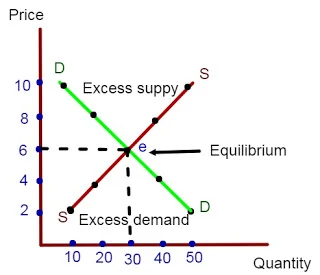Interaction between Demand and Supply/ Equilibrium
At a higher price, there would be more quantity supplied than demanded so the seller would have to lower his price to sell his goods. If the sellers raise their price too high, where the demand is less than what they have to offer, then they will have a surplus that will force them to lower their price until they can sell their entire supply.At a lower price, there would be more quantity demanded than supplied so the buyer would have to spend more to buy goods. If the sellers set their price too low, then they will sell their entire supply before they can satisfy the demands of the market. This would result in a shortage in the market.
Therefore, in a perfectly competitive market, the interaction of the forces of demand and supply determine the equilibrium price.
The process of equilibrium in the perfect competition can be explained by the help of following schedule and diagram:
When we present the above schedule in the graph, we get:
In the above diagram, we can see that above point 'e', supply exceeds demand as the price is higher and there will be a surplus of supply and below point 'e', demand exceeds supply as the price is lower and there will be a shortage of commodities. So, point 'e' is the equilibrium position where the consumer and supplier, both agree to trade with equilibrium price and quantity.



0 Comments
If this article has helped you, please leave a comment.